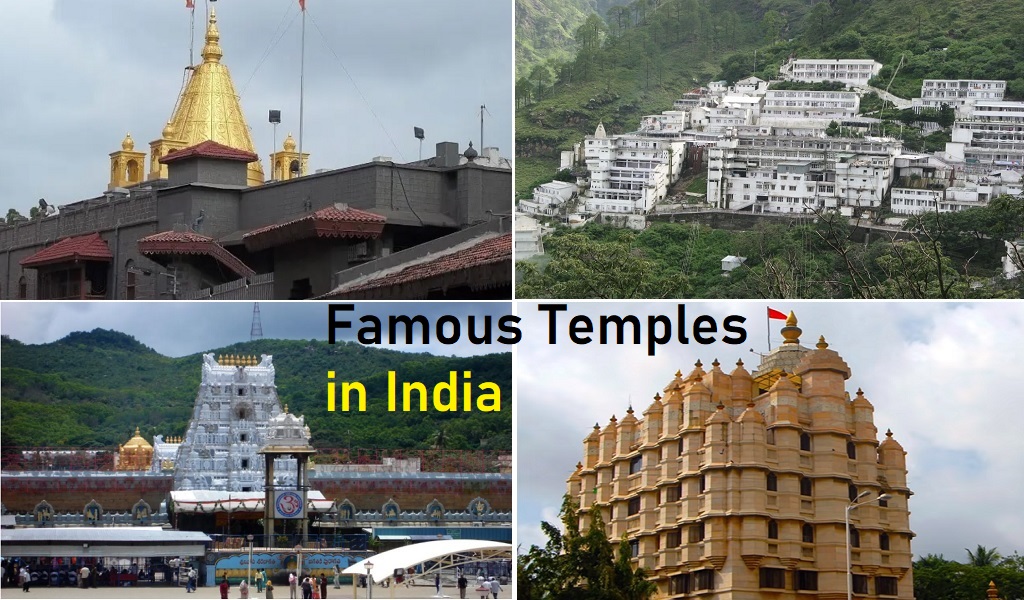Religion, belief, and faith in God are the virtues that one can find in India’s soil and air. Temples, the symbol of devotion towards God, mark every town and city of the country. Famous temples in India are age-old. There are many surviving old that dates back to the 4th century CE. Archaeological evidence of relics of ancient civilization confirms many temples’ existence even before the 4th and 5th centuries CE.
In all four directions, India has a temple that is famous for one reason or another. Famous temples in India are worth watching for any number of reasons. Some attract tourists for the architecture that make people wonder about the techniques and methodologies ancient civilizations used. Others are a source of attraction because of the stories and religious beliefs they have behind them.
Planning to visit famous temples in India will make you travel all around the country. The interiors and material used in temples reflect the cultural practices of the places. Rituals, celebrations of festivals that people carry out in these temples attract tourists worldwide. Many have entries in the Guinness book of world records for different reasons.
A visit to famous temples in India will make us proud of our rich culture, heritage, civilization, and ethnicity. They are the best sites for planning vacations, picnics, tours, and adventure camps. They take you to different environmental settings that reveal much about India’s rich natural and cultural aspects.
Famous temples in India provide mesmerizing scenic beauty
Uttrakhand is the abode of Lord Shiva. Many sacred and renowned temples of Bum Bhole mark their presence in the state. Badrinath, Kedarnath are temples that constitute the part of Chaar Dhaam yatra that have great significance in Hindu mythology. Badrinath pays homage to Lord Vishnu, and Kedarnath is a tribute to Lord Shiva.
Garhwal ranges of the Himalayas in which lie the Kedarnath temple remain snow-laden for the most year, making it essential for the tourists to fix the visit to the temple during summer months. Less cold weather and winds of cool air in this season make the visit pleasant. The extreme climate in winters makes it essential to shift the idol of shiva to Ukhimath.
In Tamil Nadu, there is another famous temple of Lord Shiva, Rameshwaram, or Ramanathaswamy. It is one of the twelve Jyotirlinga and also one of the Char Dham. The temple has two lingams. Ramalingam holds a belief to be made by Lord Rama before he preceded to fight with Ravana. The other one is Viswalingam that was brought by Hanuman from Kailash.
The temple has the longest corridor globally, comprising of 1000 halls that have carvings on them. The temple has many shrines made with dark black granite stone. The rooftops coated with gold give it a beautiful outlook.
Visit famous temples in India
On the eastern coast of India in Orissa’s state is the third of the four Char Dham temples, Jagannath Puri. The temple restricts the entry of everyone into the premises. It has strict norms that one must follow to see the temple from inside. Males need to wear dhoti, and females saree to enter the temple.
The temple has a lot of mysteries adding up to make people wonder or establish faith in God. Right from architecture to the cooking way of Parsadam in the temple has astonishing facts behind. The rath yatra, which carries, three deities attracts millions of devotees and tourists.
In the Dwarka district of Gujarat, along the banks of the river Gomti is Dwarkadish temple. Fourth of Char Dhams is the temple of Lord Krishna. It has a lot for a person interested in ancient Hindu mythology, civilization, and archeology. The temple is 5000 years old but still has a lot to attract people all across the world. The temple is at a distance of 56 steps from the Gomti river. It also has a ritual of offering 56 food items to Lord Krishna daily as Prasadam.
Virupaksha temple, standing in Hampi’s ruins, will make you visit Karnataka and see the spectacular features of the temple that add it to a World Heritage site. The musical pillars generate a melodious sound when tapped gently. On the Hazara Ram temple walls, there are carvings, antiques, and fossils that are rarest to discover in India. Many historians claim them to belong to Lord Rama’s reign. The baby elephant and Ganesha statue have stories behind their existence and presence in the temple.
Temples are expressions of devotion, faith, and belief
The only temple of Brahma Ji in India is in the Pushkar district of Rajasthan. In close vicinity of Pushkar temple lies Pushkar lake. It is a belief that the lake originated from the lotus petal that fell from Brahmas lotus. It is the temple that withstood the wrath of time. It did not get destroyed even when Aurangzeb mutilated many other Hindu temples in the region.
In Varanasi, Kashi Vishwanath, Uttar Pradesh, on the holy banks of the Ganges, is full of pilgrims and tourists all year-round. The temple was destroyed and built time and again during the reign of different emperors. One of the twelve Jyotirlingas that Hindus considers a privilege if they get a chance to visit them.
Orissa, Bhubneshwar has another masterpiece, Lingaraja temple. It is 1000 years old. People believe that ling appeared here on its own, and they worship it both as Lord Shiva and Lord Vishnu, called as Harihara. Hari refers to Lord Vishnu, and Hara is for Lord Shiva.
Somnath temple mentioned in age-old scripts Shivpuran, Skandpuran, and Shreemad Bhagvat is Jyotirlinga in Gujarat. It is a belief that here Lord Krishna ended his Lila and left for heavenly abode. People say that in the hollowness of linga lies Syamantak Mani. It is associated with Lord Krishna and has the properties of floating in the water and producing gold.
Shree Padmanaswabhamy Mandir in the Thiruvananthapuram city of Kerala is devoted to the Vishnu god. Visiting the mandir requires a person to follow a strict dress code. It is the rich temples in the world. It displays the Dravidian style of architecture and dates back to the 8th century, mentioning in epic Puranas and Vedas.
Temples in India will leave you spellbound
Mata Vaishno Devi temple has its location in the ranges of Lofty Himalayas in Jammu and Kashmir. Every year many pilgrims bow their heads at the temple. The faith and devotion people have for Mata rani have no matches. They believe that only those can reach the shrine who receives the call from Mata rani to come to her abode.
Amarnath in the lofty hills of the Himalayas allows pilgrims only in summer months. The rough terrain makes it difficult to reach the 5000 years old cave. It holds the belief that Lord Shiva told the path of mortality to goddess Parvati in this cave.
Delhi, the capital of the country, has Swaminarayan Akshardham temple. It has made its way into the Guinness workbook record for World’s Largest Comprehensive Hindu Temple.
Final Thoughts:
Famous temples in India has a lot for everyone. They are not the sites that one visits for religious homage. The magnificent architectural style has everything to inspire future engineers and architects. The cultural inscriptions, carvings reflect the richness ancient civilizations had. The artistic style shows the influence of colors, and shades, making the sculptures and idols more realistic and natural.
Famous temples in India convey the real idea behind the construction of masterpieces. Temples were a powerhouse of energy that filled the person with positive vibes and potentials, taking away the negativity. The pious and peaceful temples attracted positive vibes and made them places full of serenity, power, and calmness.
While planning to visit famous temples in India, one should observe details that make each temple unique and special. It is a privilege if one gets the opportunity to see any of the masterpieces. They are eye-openers that will make us find the right path and direction, leading us to meet our final destination.
Famous temples in India reveal the richness of Hindu culture and mythology. They are wonders of science, technology, and architecture. Planning a visit to these temples will be an enriching experience. A visit to these temples will give insight into Hindu culture and religion’s art, culture, and ethnicity. One should equip oneself as per the specific needs of temples. Each has its demands, depending on its location and environmental conditions.

















